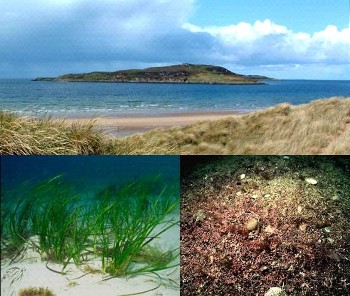Loch Gairloch marine protected area? meeting, 15th December 2010
Posted: Thursday 16 December, 2010 @ 09:35:14

The meeting was convened with two main objectives (i) to inform local people of the nature and purpose of the underwater survey carried out during 2010 by Scottish Natural Heritage and Herriot-Watt University in the Gairloch, Loch Ewe, Two Brooms and Summer Isles areas, and investigation by members of WREN [Wester Ross Environment Network] earlier in the year (ii) to give local people a chance to debate, and contribute to, the Marine Protected Area process. The event was very well attended with a mixture of fishermen and other local stakeholders.
SNH representative Katie Gillham described the process of identifying and defining areas with “Priority Marine Features” (PMF) and the pathways by which such information was collated into a form that could provide the basis for establishing a cohesive network of Marine Protected Areas around Scotland. The primary task of the studies to date was to provide ministers with the information necessary to make decisions relating to the effective management of Scotland’s marine resources. Katie emphasised the consultative nature of the process, and the opportunities for local input at all stages.
A more technical presentation by Colin Trigg revealed some interesting findings with respect to the health of PMF in the local area. Sea grass beds in Gairloch were more extensive than expected from historic information, and a new bed was found in Gruinard Bay. Maerl beds (a calcareous red alga) were much more extensive than expected in Gairloch, although the beds in Loch Ewe were in poor condition. Phosphorescent Sea Pens were particularly dense in Gairloch, and the presence of the Northern Feather Star 2.5 nautical miles southwest of Longa Island was a first record for the area. So, many interesting findings reported from Gairloch.
This rather positive biological report stimulated considerable debate, and contributed to clear concerns from fishermen. The primary concern was that, as a result of these studies, Gairloch would be declared a Marine Protected Area, and large areas would be closed to all commercial fishing [Loch Gairloch has been closed to mobile fishing gear since 1984]. As an example, the survey had identified a large area of “burrowed mud” in central Gairloch. This is primary habitat for prawns, and the local concern was that such an area, having been highlighted by the survey, might be closed to fishing with major consequences to fisheries livelihoods. The SNH team emphasised that there was no intention to establish blanket no-take areas anywhere. Any restrictions that arose as part of an MPA (and there is at present no plan to so designate Gairloch) would be carefully evolved in consultation with local resource users.
The over-riding outcome of a thought provoking evening was, perhaps, that the importance of consultation cannot be over-emphasised. Fishermen pointed out that nobody had asked them where to look for the target species, and during the presentations it became obvious that they could offer a great deal of advice. Indeed some fishermen contributed information to the SNH staff, on the spot! Above all, the view expressed by those most directly involved was – conservation yes, but for a clear purpose. We have to see a clear return for investment in Marine Protected Areas at a time when resources are tight everywhere.
Thank you to Gairloch High School and janitor Andy Bowker for providing a venue and support, to Katie, Colin and Aaron Forsyth for their presentations, Prof Barry Blake for taking notes, and to everyone who attended the meeting. The meeting was organised by WRFT Biologist, Peter Cunningham, who invited the SNH marine team to the area to present the findings of their survey.
Information on marine conservation in the Marine (Scotland) Act can be found at:
http://scotland.gov.uk/Topics/marine/seamanagement/marineact/marineconservation
Basic Background information on Marine Protected Areas for nature conservation can be found at: